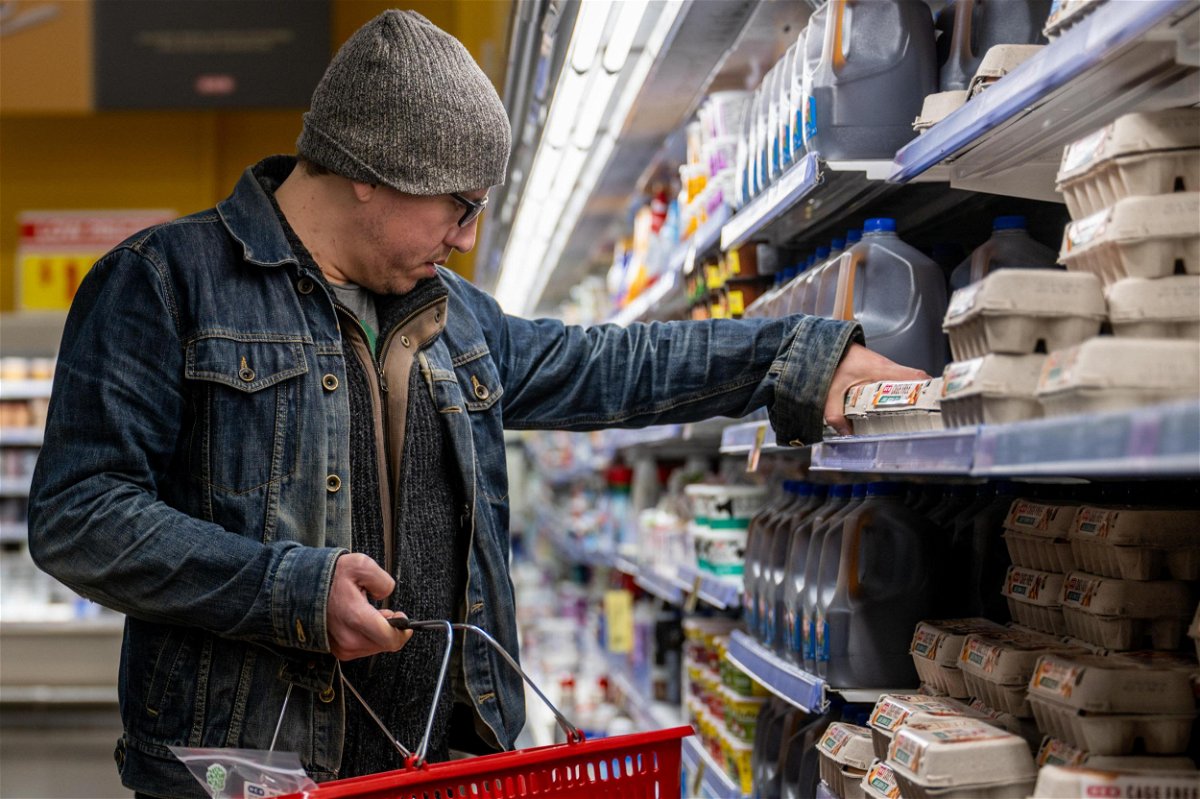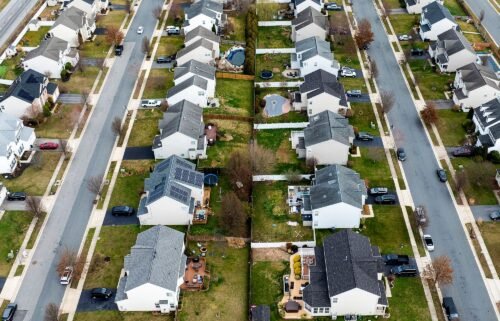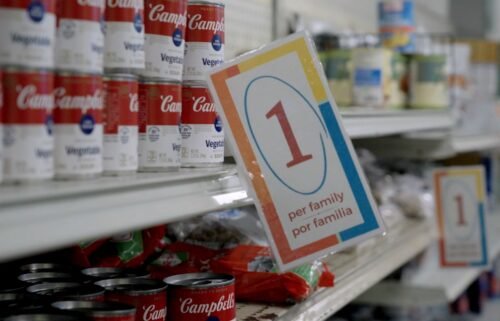Inflation is nearly back to normal. But high prices have changed Americans’ lives

A customer shops for eggs at a H-E-B grocery store on February 08
Eagan, Minnesota (CNN) — The winter holidays typically make for busier times at The Open Door Pantry food shelf here in this Twin Cities suburb.
And sure enough, on the Monday before Christmas, the day’s food appointments were chock-full. In the back warehouse, nearly 100 volunteers quickly and methodically sifted through thousands of pounds of freshly donated food.
But the activity isn’t simply a seasonal surge: The daily appointments are booked solid through the end of January, and demand has been overwhelming for The Open Door’s other community-based food distribution events.
While 2023 was the year that meaningful progress was made on slowing down painfully high inflation, 33 months’ worth of fast-rising prices took their toll on many Americans, especially those with lower incomes.
To that point, this year also marks a record year for food pantry visits in Minnesota and beyond — in many cases, by a country mile.
“The years of inflation, they stacked on top of each other,” said Jason Viana, The Open Door’s executive director. “We were seeing the impact of [rising wages], but inflation wiped all that out.”
Turning the corner?
In 2022, the US saw inflation spike to levels not seen in four decades, and the Federal Reserve was in the throes of a historic rate-hiking campaign to cool it back down.
At the start of this year, inflation had moderated some — the Consumer Price Index had cooled to 6.5% in January 2023 from its 9.1% peak in June 2022. However, the US economic outlook was clouded by ongoing fears that the aggressive Fed campaign would lead to a downturn.
Those dire predictions did not materialize.
It currently appears that the Fed has turned the corner on its lengthy battle to bring down inflation without the economy careening into a recession.
The labor market remains strong, which has helped to fuel consumer spending and keep the broader economic engine churning. The housing refinancing boom of previous years and the resurgent stock market have made many — but certainly not all — households wealthier.
“It’s been a difficult few years, but I do think that in 2023, the situation is improving for households as inflation has slowed and as wage growth has remained above the pre-pandemic trend,” said Gus Faucher, senior vice president and chief economist of the PNC Financial Services Group.
But he also noted that many lower-income Americans are still struggling.
“The types of prices that went up in 2021 and 2022, they tend to carry more weight for lower-income households, and they obviously had less of a cushion to start with.”
The latest reads on inflation show that the pace of price hikes has cooled substantially.
The Consumer Price Index measured 3.1% annually in November, and the Personal Consumption Expenditures price index not only came in even lower at 2.6%, but also declined monthly for the first time since April 2020.
But there’s still a long way to go before inflation is where the Fed wants it.
The earlier price increases became pervasive and “sticky,” meaning that once prices go up, they don’t easily go down. That’s making it that much more difficult to bring consumer costs back to their levels before recent jumps.
For much of this year, Fed Chair Jerome Powell cautioned that the return of inflation to the central bank’s 2% target could be long and bumpy. To that end, the Fed’s latest economic projections don’t have the core Personal Consumption Expenditures price index settling in at 2% until 2026.
Soaring fuel costs, surging food prices
Although the speed of price hikes has gotten better, that’s not to say it’s been pleasant by any means.
“Consumers remember a couple of years ago when they could buy something for quite a bit less,” said Kayla Bruun, senior economist with market research and analytics company Morning Consult. “Food prices are a very visible [piece] and something you’re buying very frequently, and there’s a lot of awareness of what those prices are, maybe second only to gas prices.”
She added: “That’s what sticks in their mind the most and what they cite as what bothers them the most. Housing is the other thing I would point to that is a continued strain.”
More than 90% of the items tracked in the Consumer Price Index are more expensive than they were in February 2020, with most price increases landing north of 20% and some (fuel and margarine) approaching 55%, Bureau of Labor Statistics data shows.
Food prices are nearly 25% higher.
However, audio-visual buffs might be the only ones rejoicing as televisions and electronics hardware are among the scant few categories that have actually seen prices decrease since before the pandemic.
“Even as your inflation rates slow, prices are still well above where they were ahead of the pandemic,” said Shannon Seery, an economist with Wells Fargo. “Households are still grappling with that. Obviously, a slowing price growth environment is beneficial, but when you have the price growth we’ve had over the past few years, it kind of compounds on itself.”
That layering effect of inflation compounded with decades-high interest rates as well as the expiration of pandemic emergency measures further squeezed households’ budgets and forced many to rely on food donations, Merissa Piazza, a senior policy analyst for the Federal Reserve Bank of Cleveland, wrote in a November blog post.
“Low-income households are particularly vulnerable to these increases because they spend a greater share of their income on food,” she wrote.
As such, food banks have seen spikes in demand, Piazza wrote, using the Greater Cleveland Food Bank as an example. Pandemic-era visits peaked in August 2020 and bottomed out in January 2022, then ratcheted higher to surpass the pandemic total in August 2023.
‘Absolute hope’ for relief
Minnesota food shelves are on track to log a record 7 million visitors this year, said Colleen Moriarty, executive director of Minnesota Hunger Solutions. In 2022, there were 5.5 million food shelf visits across the North Star State.
Among those visitors were Apple Valley, Minnesota, residents Paul Mentzos and Abbella DiNoto, who were put in contact with CNN Business through The Open Door Pantry.
“I’ve been barely getting by, by the skin of my teeth, for the last three years since Covid,” said DiNoto, 50, who said she is a disabled veteran on a fixed income. “With the cost of food, the cost of everything going up, I’m getting to the point where I have zero money left over at the end of the month.”
DiNoto said she has racked up credit card debt to cover unexpected expenses.
“This month, I could not pay any of my bills,” she said. “And my debts and my bills are mounting, and now I’ve got late payments hitting me and all these credit card fees, and now my minimum payments have gone up, and I’m hurting bad.”
Mentzos, 71, spent 43 years of his life driving a taxi around the Twin Cities and raised four children, two of them as a single father, he said.
“I’m very accustomed to being, well, the word would be ‘poor,’” he said. “I’ve been there where I had to cut corners just to eat, and rob Peter to pay Paul.”
He added: “You’ve got to watch every dollar you spend. You’re going to the store with a calculator and watch out so you’re not embarrassed at the checkout because you have overrun [your money.]”
With the expiration of additional Supplemental Nutrition Assistance Program benefits and the rising prices, Mentzos has had to rely on food shelves more lately.
Inflation is expected to let up further through 2024, a year that could see some relief as well on the interest rate front.
Such a combination could give Americans more breathing room and hopefully be enough to bring those who are struggling the most back from the brink, said The Open Door’s Viana.
“If inflation can stay down, and wages can continue to grow, there is absolute hope that families will be able to get back on their feet and require less support,” he said.
The-CNN-Wire
™ & © 2023 Cable News Network, Inc., a Warner Bros. Discovery Company. All rights reserved.


